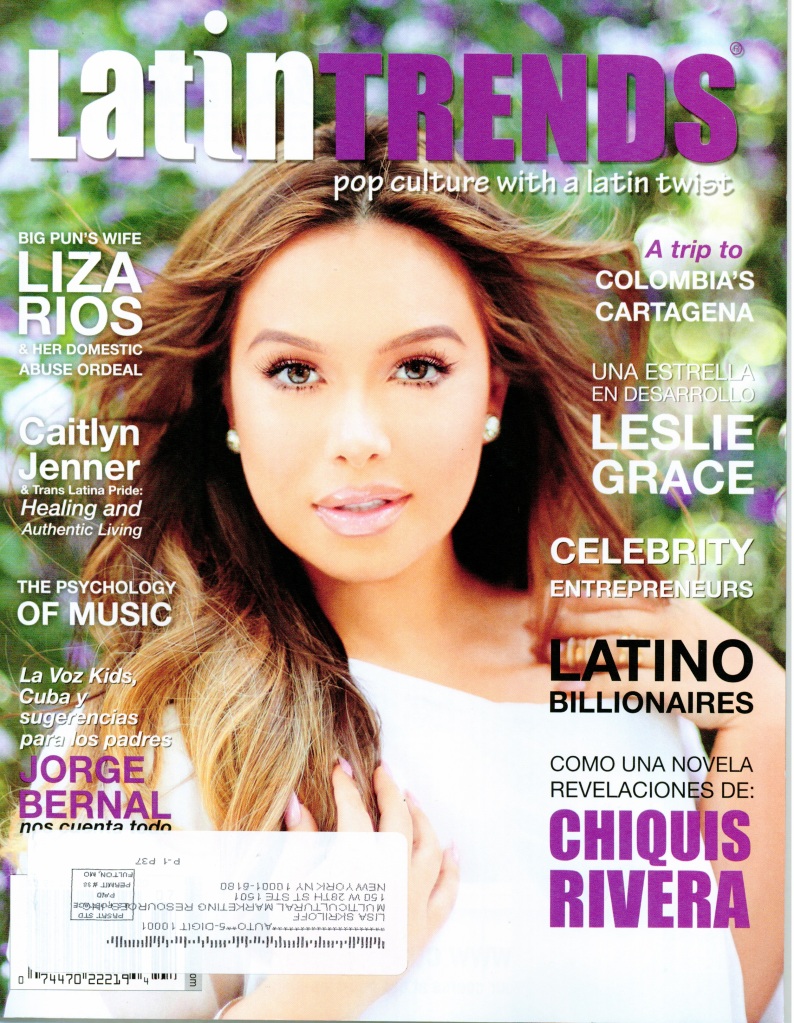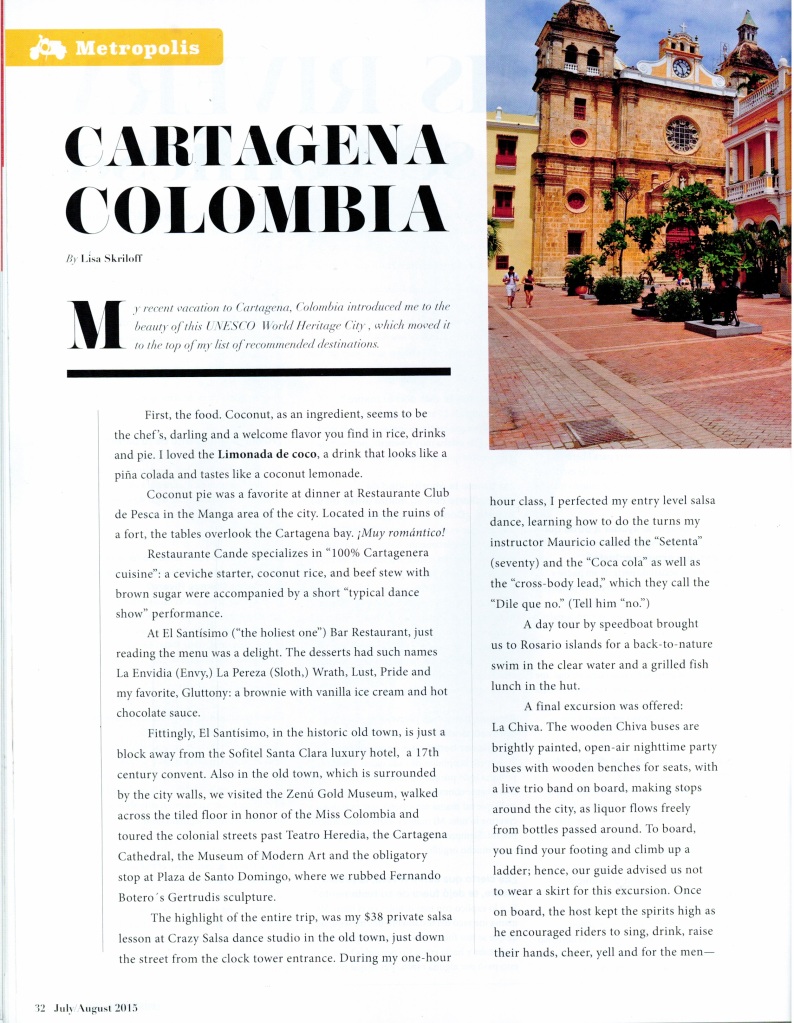Salsa Lessons and More in Cartagena, Colombia, By Lisa Skriloff (as appeared in LatinTrends July/August 2015 issue)



Cartagena, Colombia, By Lisa Skriloff
(original full length article)
Wipe that outdated reputation from your mind. My recent vacation to Cartagena, Colombia introduced me to the beauty of this UNESCO declared World Heritage City and moves it to the top of my list of recommended destinations.
The country’s famous export? Think coffee. Safety concerns? Why, Disney Cruise Line “calls” there now. What surer hallmark of safety “stamp of approval” than Disney bringing its guests to this city? Cartagena is another in the line of cities transformed from “terrorism to tourism” as the then president Uribe declared in 2002.
My pre-Colombian vacation knowledge was limited to ceviche, arepas and salsa.
Now I know about champeta (a kind of reggaeton music and dance,) lulo (a fruit) and Getsemaní (neighborhood of Cartagena.)
First the food. Coconut as an ingredient seems to be the chef’s darling and a welcome flavor it is, in rice, drinks and pie. I had been advised to be on the lookout for “Limonada de coco,” a drink that looks like a piña colada and tastes like a coconut lemonade. Once I tried it, a second one was on the way.
Other new fruit to try included “lulo” (a little orange with a lemony pineapple flavor) and, available every morning on the breakfast buffet, a “tomate de arbol” which gives the sensation in your mouth of eating a tomato but tastes like a citrusy apricot.
The coconut pie was my immediate favorite on the first night, at dinner at Restaurante Club de Pesca in the Manga area of the city. The restaurant is located in the ruins of Fort San Sebastian del Pastelillo, and tables overlook the Cartagena bay. From some tables you glimpse the water looking through the fortress wall cut outs where the cannons once were positioned. ¡Muy romántico!
If you like dining and drinking in restored ruins, also pay a visit to Casa de la Cerveza, located on top of the city wall, at the end of Calle Arsenal with views across the water toward Castillo de San Felipe fortress.
This part of town, Getsemaní, is the rehabilitated section, the Times Square of Cartagena, if you will, once seedy, now social, or perhaps better compared to Chueca in Madrid, a revitalized hipster zone.
Another night we ate at Cánde, specializing in “100% Cartagenera cuisine”. A ceviche starter, the coconut rice, the beef stew with flavor of brown sugar were accompanied by a short “typical dance show” performance. The owners, apparently, are fans of the live dance show as they also offer one at their other restaurant, El Burlador de Sevilla. There, a flamenco dancer and guitarists give 30 minute shows throughout the evening. At this Spanish restaurant we enjoyed a kind of nouveau paella, tapas and, of course, their sangría. The performer (loved her flamenco dance to “My Way”) gave a shout out to a celebrity diner in the audience, Señorita Bolivar (a local version of “Miss New York State” : Cartagena is located in the “department” of Bolivar.)
At El Santísimo (“the most holy one”) Bar Restaurant just reading the menu was a delight with dishes with names such as “Melchor, Gaspar y Baltazar”, “Sacrilege” and the main course I selected “San Martín Pescador,” a fresh fish fillet with calamari and shrimp sauce. Desserts, of course, are La Envidia (Envy,) La Pereza (Sloth,) Wrath, Lust, Pride and my favorite, Gluttony, a brownie with vanilla ice cream and hot chocolate sauce.
Fittingly, El Santísimo, in the historic Old Town, is just a block away from the luxury hotel Sofitel Santa Clara built in a 17thcentury convent. Also in the Old Town, which is surrounded by the city walls, we visited the Zenú Gold Museum, walked across the tiled floor in honor of the Miss Colombias of the past, and toured down the Colonial streets past the Teatro Heredia, Catedral de Cartagena, the Museum of Modern Art and the obligatory stop at Plaza de Santo Domingo to rub the sculpture of Gertrudis, by Fernando Botero. A coffee appreciation lesson at Café San Alberto and an emerald jewelry making class at Fundación Escuela de Joyería del Caribe netted me two suitable-for-framing certificates of attendance.
But my favorite class, the highlight of the entire trip to Cartagena, was my $38 private salsa lesson at Crazy Salsa dance studio in the Old Town, just down the street from the Clock Tower entrance. During my one hour class, I perfected my entry level salsa dance, learning how to do the turns my instructor Mauricio called the “Setenta” (70) and the “Coca cola”. The “cross body lead” I knew how to do but here in Cartagena he says they call it the “Dile que no.” (Tell him “no.”) Mauricio added in a bit of what their brochure calls “Lady styling” and I learned how to move my hands, like, he said “you are painting a wall.”
After that I was ready for Donde Fidel, a nearby salsa bar with dancing with its collection of salsa legends photos on the wall, and Café Havana, in Getsemaní, where the live salsa band starts at 1130 pm and I got to practice my new salsa moves (thank you Luis!).
Other worthwhile sightseeing stops were at the San Felipe fortress and the La Popa monastery situated at the highest point of Cartagena, with fabulous views of the harbor area (and from where I spotted the Disney cruise ship pointed out by the passengers on their ‘Best of Cartagena’ day excursion.)
We stayed at the Radisson Cartagena Ocean Pavillion Hotel, directly on the beach, with rooms with a view of the Caribbean Sea, about 15 minutes from the Old City, and just north of the airport. (Colombia is the only country in South America with both a Caribbean and Pacific Ocean coastline.) Nearby is another beach resort, Hotel Las Américas Resort, Spa and Convention Center with a notable infinity pool and beach area with attendants.
Less luxurious but rewarding in its own way was our canoe tour of the nearby mangrove swamp. Ecotours Boquilla offers a one hour excursion into the heart of the mangrove forest into tunnels and out again. If the canoes seem tippy, not to worry. As we circled a bend I noticed a local walking by in the water, which must have been less than 2 feet deep.
A day tour by speedboat brought us to Rosario islands for a back to nature swim in the clear water and a grilled fish lunch in the hut. Not too rustic – there was wifi (password Laguna01). That’s about as far back to nature as I go.
A final excursion was offered: La Chiva. The wooden Chiva buses are brightly painted, open-air nighttime party buses with benches for seats, with a live trio band on board, making stops around the city, as liquor flows freely from bottles passed around. To board, you find your footing and climb up a ladder; hence our guide advised us not to wear a skirt for this excursion. Once up there, the party bus host kept the mood high as he encouraged riders to sing, drink, raise their hands, cheer, yell and for the men — row by row – to pull their pants down. At the stop in front of the San Felipe fortress, it was down the ladder and off the bus for 20 minutes to dance and conga line. At the Las Bóvedas one hour stop, the dungeons-turned-shops are closed for the night but there is more dancing and cheese arepas for sale and then it’s back up the ladder onto the bus and onto the final destination, a private disco for the chiva partyers. If you like a spring-break/bachelorette party, open bar atmosphere amongst a traveling group of 50 tourists from all over South America (“Venezuelans, make some noise,” the MC exhorted), like jokes in Spanish and can easily scamper up and down a bunk bed type ladder, then this will be a fun night for you. If you are older than 35, your knees sometimes hurt and you appreciate “quiet enjoyment”, if your guide suggests the group takes the Chiva tour, then “dile que no.”
By Lisa Skriloff








